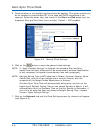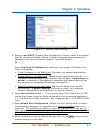
Chapter 4: Operation
724-746-5500 | blackbox.com 4-1
4. General Information
After the Auto-Sync Time Clock has been unpacked, wall mounted (optional),
connected to a network, and plugged into AC power, the Zeroconf capability should
allow the clock to be automatically detected with a Web browser. It is
recommended to install and use the Auto-Sync Utility that came on the CD included
with your Auto-Sync clock if:
Your browser does not support the Bonjour plug-in, or you do not want to install
Bonjour.
You want to use the features of the Utility to; find clocks, obtain clock setup,
obtain clock transactions (timesync info), monitor clocks status on the network,
and perform diagnostic functions.
It is recommended to obtain the maximum functionality from the Auto-Sync Time
Clock by:
Configure the system settings including: clock name, unique clock description,
time zone, and Daylight Saving Time (DST), etc., that are applicable to your
installation (using the browser).
Assign the NTP servers that will be used to synchronize the
Auto-Sync Time Clock (either internal or external).
Enter information to generate e-mail notification.
Enter information to generate SNMP Trap alerts for network.
Enter FTP Server information for Backup of configuration and transaction report
files.
Prepare schedules for: time synchronization, reports, and backup.
NOTE: The Auto-Sync Time Clock configuration parameters, which are retained in
the clock, usually remain unchanged after installation and setup.
About Bonjour and Zero-Configuration
Bonjour, also known as Zero-Configuration networking, enables automatic
discovery of the Auto-Sync Time Clock on IP networks. Bonjour uses industry
standard IP protocols to allow devices to automatically be discovered without the
need to enter IP addresses or configure DNS servers.
Bonjour, formerly Rendezvous, is Apple Inc.'s trade name for its implementation of
Zeroconf, a service discovery protocol. Bonjour locates devices such as the Auto-
Sync Time Clock, printers, copiers, and other computers, with the services that
those devices offer on a local network using multicast Domain Name System service
records. The software is built into Apple's Mac OS X operating system from version
10.2 onwards, and can be installed onto computers using Microsoft Windows
operating systems.
Bonjour is a networking protocol that sends and receives network packets on User
Datagram Protocol (UDP) port 5353. If you have a "personal firewall" enabled, you
will need to ensure that UDP port 5353 is open for Bonjour to work correctly.


















